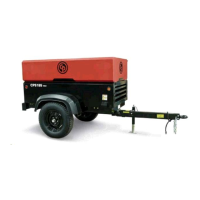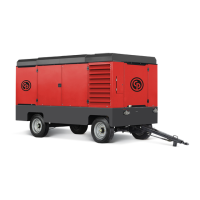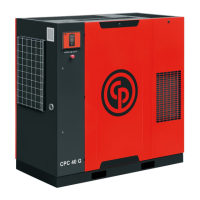
Do you have a question about the Chicago Pneumatic CPS 185 KD S8 T4F HOP and is the answer not in the manual?
| Model | CPS 185 KD S8 T4F HOP |
|---|---|
| Type | Portable Air Compressor |
| Free Air Delivery | 185 cfm |
| Fuel Type | Diesel |
| Weight | 1, 965 lbs |
| Emissions | Tier 4 Final |
| Noise Level | 76 dB(A) |
| Engine Power | 49 hp |
| Max Pressure | 125 psi |
| Power | 49 hp |
Overview of safety practices for operating, maintaining, and repairing the compressor.
General guidelines for safe operation and maintenance of machinery and equipment.
Guidelines for safe operation, including lifting, towing, and general usage of the compressor.
Precautions to be taken during maintenance, overhaul, and repair activities.
Safe usage guidelines for various tools and equipment during maintenance and repair.
Safety measures related to battery handling, charging, and maintenance.
Comprehensive safety guidelines for lifting, hoisting, and securing loads.
Safety measures for noise, fumes, dust, and handling hot parts or chemicals.
Explanation of safety symbols used in the manual and their meanings.
Overview of the CPS 185 KD compressor, including engine, compressor, and systems.
Details on the compressor's frame, axles, drawbar, and braking systems.
Description of the compressor's bodywork, including openings and doors.
Information on the location and accessibility of the compressor's lifting eye.
Location of the control panel on the air compressor unit.
Details found on the compressor's data plate, including model and specifications.
Visual illustration of the compressor unit with labeled main components.
A list of main components with their corresponding reference designators and names.
Diagram illustrating the compressor regulating system in load condition.
Description of how air flows through the compressor system.
Description of the compressor's oil system components and function.
Explanation of the continuous regulating system and its operation.
Steps for preparing the drawbar for towing the compressor.
Guidelines for safely parking the compressor on various surfaces and locations.
Procedures for safely towing the compressor unit with a vehicle.
Procedures for safely lifting the compressor unit using appropriate equipment.
Pre-operation checks required before starting the compressor.
Instructions for operating the battery switch for the compressor.
Information on the emergency stop button and its usage.
Overview of the XC1004 controller functions and its panels.
Overview of the control panel, its buttons, and their functions.
Explanation of icons displayed on the controller screens.
Icons for controller settings menus and production tests.
Step-by-step guide for starting the compressor.
Step-by-step guide for stopping the compressor.
Descriptions of the main, alarm, and setting views.
Explanation of the controller's timer view and its activation.
Information on Chicago Pneumatic service paks for compressor and engine maintenance.
Summary of maintenance tasks and intervals for the compressor unit.
Recommended lubrication oils for the compressor and engine.
Information on engine coolant type and order numbers.
Procedure for checking the engine oil level.
Procedure for checking the compressor oil level using the oil level gauge.
Procedure for changing engine oil and filter.
Procedure for changing compressor oil and filter.
Safety instructions and information regarding battery electrolyte.
Procedure for safely recharging the compressor's battery.
General battery maintenance tasks, including cleaning and terminal checks.
Procedure for adjusting the continuous regulating system of the compressor.
Diagnosing and resolving issues with reduced compressor capacity or pressure.
Resolving issues where receiver pressure exceeds limits, causing safety valve activation.
Important precautions regarding the alternator and battery connections.
Detailed specifications for the compressor and its engine.
Standard conditions under which the compressor's performance is measured.
Operational limits and restrictions for the compressor unit.
Design specifications for the compressor unit.
Design specifications for the engine, including make, type, and bore.
Design data related to the overall unit, such as tank capacity.
Additional remarks and notes pertaining to design data and specifications.
Information on Chicago Pneumatic's approach to product disposal and environmental responsibility.
Instructions for separately disposing of contaminated substances and machine components.












